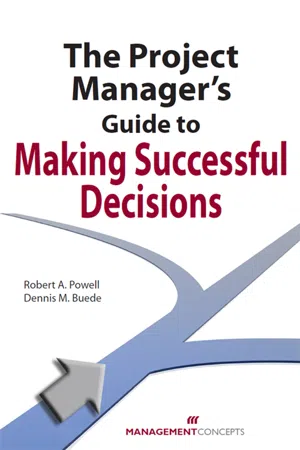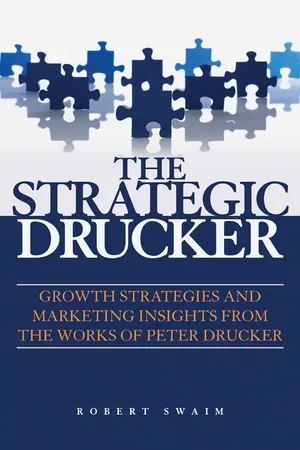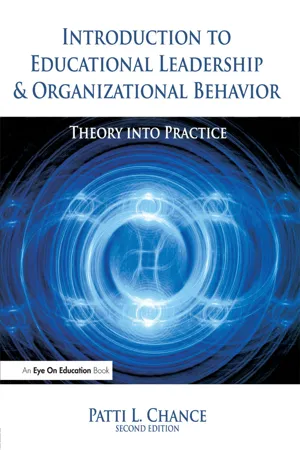Decision Making
Decision making involves the process of selecting the best course of action from among various alternatives. In a business context, decision making often involves gathering and analyzing relevant information, considering potential risks and benefits, and ultimately choosing the most effective strategy to achieve organizational goals. Effective decision making is crucial for the success and growth of a business.
7 Key excerpts on "Decision Making"
- Vibrant Publishers, Callie Daum(Authors)
- 2020(Publication Date)
- Vibrant Publishers(Publisher)
...Planning and Decision Making One of the most important things you will do as a manager is make decisions. It is a primary function of management that should be done carefully in order to make rational and sound decisions. A decision is a choice made between different courses of action in circumstances of ambiguity to best achieve the desired outcome or objective. Decision Making is a thought process of selecting the best choice from the available possibilities. This process includes considering the positives and negatives of each option and consideration of all alternatives to forecast the possible outcomes. Recommended steps for making a thoughtful decision include: a) Defining the problem or the decision to be made b) Gathering information and collecting data c) Identifying the options and possibilities d) Considering the data e) Choosing an alternative f) Implementing the alternative g) Reviewing the decision made and evaluating the consequences. Define the Problem Make sure to clearly detail and document the problem or decision that needs to be made. Clearly defining what needs to be addressed is crucial to success. Gather Information Gather information from various sources pertaining to the decision. What is the current state of the issue? What do you want the future state to look like? Determine what information you need, where is the best place to get it, and how you will obtain the information. Identify the Options While sorting through the information gathered, various options and alternatives will become evident. Document those options and use those options to create new ones. Listing all feasible alternatives is critical in coming to an informed decision. Consider the Data Examine each of the possibilities you have outlined and weigh the pros and cons. Forecast what the outcome may look like should you choose a particular option...
- Robert A. Powell, Dennis M. Buede(Authors)
- 2008(Publication Date)
- Berrett-Koehler Publishers(Publisher)
...While both instinctive decisions and thoughtful decisions are needed, this book focuses on the latter, thoughtful decisions based on cognitive processes—that is, cognitive decision-making. Cognitive decision-making usually considers many options and addresses their relative pros and cons to some degree. The authors hold that too many people (including project managers) make instinctive decisions when thoughtful decisions would serve them better. This chapter is intended to help them and others become more conscious of how best to tackle any kind of decision. This chapter presents the following sections: The Basics Literary Views of Decision-Making Decision Quality History of Decision-Making Approaches to Decision-Making Decision-Making Methods and Aids Implementing the Decision. The Basics So what is a decision? The American Heritage Dictionary of the English Language, 4th edition (2000) provides several definitions, the first three of which are: The passing of judgment on an issue under consideration. The act of reaching a conclusion or making up one’s mind. A conclusion or judgment reached or pronounced. Howard (1968), who coined the term decision analysis, defines a decision as “an irrevocable allocation of resources.” Resources that can be allocated irrevocably are money, time, and physical entities such as cars and manufacturing equipment. Recall our modification of Bocquet, Cardinal, and Mekhilef’s (1999) definition of decision: any action taken by an actor(s) that will consume resources and affect other actors in the pursuit of achieving objectives within constraints. A further revision of our modification of the definition of decision will build upon both of these definitions but will emphasize that decisions are typically made to allocate current resources in the hope of achieving a return in future resources...
- eBook - ePub
Media Management in the Age of Giants
Business Dynamics of Journalism. Second Edition.
- Dennis F. Herrick(Author)
- 2012(Publication Date)
- University of New Mexico Press(Publisher)
...CHAPTER FIVE Decision Making Nothing is more fundamental to leadership and effective management than the ability to make the right decisions, make them in a timely way, and implement them correctly. — Dennis Herrick, former publisher Good Decision Making must be the first priority for an owner or manager. When you make the wrong decision, you must be insightful and courageous enough to admit you made a mistake and come up with a better alternative. If you change your mind too often, of course, you will come across as indecisive. You need to consistently make good decisions from the beginning. Ironically, the most effective decision makers spend little time, relatively speaking, in actually making decisions. They spend more of their time obtaining information and processing it, they delegate authority so others closer to the problem can respond to it while they only provide oversight and accept ultimate responsibility, and they organize their systems so that many decisions are made on automatic pilot. On the last point, it is not necessary, for example, to continually reassess and therefore re-decide many issues that repeatedly come before a business. In other words, reserve Decision Making for the important decisions that rise to your level in the organization. Until others prove to be unreliable, trust those below you with their decision-making duties and do not ambush those above you. Concentrate on the decisions expected of you, and even then first ensure they are worthy of your attention before spending time and energy on them. Resist the very real temptation to tackle easy questions—don’t waste your talents on trivia or routine decisions, neither of which have any meaningful consequences. Those should be delegated or at least designated as a low priority...
- eBook - ePub
The Strategic Drucker
Growth Strategies and Marketing Insights from the Works of Peter Drucker
- Robert W. Swaim(Author)
- 2011(Publication Date)
- Jossey-Bass(Publisher)
...This latter view may be an overgeneralization and may depend more on the magnitude of change that occurs when the decision is implemented. Drucker added: “Good decision makers also know that a decision is a commitment to action, it must get people to act and be implemented.” 8 Finally, he argued that Decision Making consists of Elements and Steps, which will be reviewed in this chapter. Elements of Decision Making In The Effective Executive, Drucker described the following Elements of Decision Making: 9 1. Determining if a decision is necessary and classifying the situation/problem as generic or unique 2. Defining the problem 3. Satisfying boundary conditions and specifications for the decision 4. Deciding what is right 5. Converting the decision into action 6. Feedback: Is the decision being implemented and is the problem being resolved? What Is a Decision? According to Drucker, “A decision is judgment and a choice between alternatives.” He went on to say, “It is rarely a choice between what is right or wrong, at best it is a choice between ‘almost right’ and ‘probably wrong’—but more often a choice between two courses of action neither of which is probably more nearly right than the other.” 10 Although this may sound as though the decision maker has no idea of what he or she is deciding, these views are supported by earlier research in decision-making theory that have led to the description of two decision-making models, a Rational Model and a Bounded Rationality Model. 11 The Rational. Model of Decision Making The Rational Model is described as a logical, step-by-step approach to Decision Making, with a thorough analysis of alternatives and their consequences...
- eBook - ePub
Introduction to Human Factors
Applying Psychology to Design
- Nancy J. Stone, Alex Chaparro, Joseph R. Keebler, Barbara S. Chaparro, Daniel S. McConnell(Authors)
- 2017(Publication Date)
- CRC Press(Publisher)
...Studies of decision-making reveal that decision-makers employ rules of thumb and systematic tendencies called heuristics and biases, respectively, that reduce the cognitive demands of the decision-making process. It is important to understand how heuristics and biases influence the outcomes of decision processes, as well as the impact of task and situational demands on decision outcomes. We also need to consider how the decision process changes as individuals gain experience, as evidence suggests that the decision-making processes of experts differ considerably from those of novices. This chapter reviews the role of biases, stress, expertise, and other factors on decision-making and explores the use of design of aids to support decision-making. 7.1 CHAPTER OBJECTIVES After reading this chapter, you should be able to: Describe the two major approaches to decision-making. Describe the different types of heuristics and decision biases that are characteristic of human decision-makers. Describe some of the attributes of experts and nonexpert decision-makers. Explain what decision aids are and how they can improve decision-making. 7.2 WHAT IS DECISION-MAKING AND WHY DO WE STUDY IT? Decision-making is generally defined as a task requiring an individual to choose among several alternatives with some uncertainty regarding which choice is the best one. Typically, this process is extended, requiring a choice to be made on the order of minutes or longer, using whatever information may be available. By understanding how individuals make decisions, what information they use, and what decision-related tasks they find difficult or perform poorly, the human factors expert can determine how to change the environment so individuals make better decisions. If you recall from Chapters 3 and 4, there are optimal ways to present information to individuals using displays...
- Patti Chance(Author)
- 2013(Publication Date)
- Routledge(Publisher)
...Generic decisions are routine or recurring problems that can be solved through established policies and procedures. Unique decisions are those requiring creative solutions where there are no applicable guidelines or policies. Herbert Simon’s (1960) model of Decision Making, discussed more fully later in this chapter, categorized decisions along a continuum from programmed to nonprogrammed. Once a leader determines what type of problem is being faced, analysis continues by evaluating the importance of the problem, ascertaining what further information is needed, and verifying time constraints within which a decision must be made. The next stage is the identification of the criteria for an acceptable solution. Criteria are used to judge or evaluate possible alternatives. Hopefully, the criteria used to judge possible solutions are compatible with the organization’s mission and goals. The superintendent who always measures a decision by whether it is in the best interests of students is an exemplary model of this aspect of Decision Making. A critical area in Decision Making is the development of a plan of action. This involves brainstorming alternative solutions, identifying consequences of each alternative, and evaluating each solution against the established criteria. Although the ideal decision-making model calls for an exhaustive list of all solutions, in reality, administrators will consider only a limited number of alternatives. This results from both time constraints placed on Decision Making as well as the limited capacity of an individual to conceive of all possibilities. Because creative and reasonable decisions are time-consuming, administrators often tend to act too quickly...
- eBook - ePub
The Essential Management Toolbox
Tools, Models and Notes for Managers and Consultants
- Simon Burtonshaw-Gunn(Author)
- 2009(Publication Date)
- Wiley(Publisher)
...In addition, as part of customer care training, many organizations are encouraged to ‘step into the customers’ shoes’ to identify and solve problems on behalf of their customers. Decision Making and problem resolution should be considered to be not just a process to be deployed when issues need to be addressed but also a proactive way to promote innovation and encourage creativity within the organization. Decision Making, PROBLEM SOLVING AND CONTINGENCY PLANNING This model shows a suggested linkage between the causes of past problems and an understanding of possible future problems which can provide information on which to undertake effective Decision Making. STEPS IN PROBLEM ANALYSIS AND Decision Making An iterative process is shown in this model of problem analysis and Decision Making. The model offers a number of possible starting positions (★) depending on the level of information known about the problem. This model was published in The Management Task by Rob Dixon, 2002. Copyright Elsevier. TRADITIONAL FOUR STEP MODEL TO PROBLEM SOLVING While there are a number of ways to solve problems some solutions give rise to new problems. PROBLEM SOLVING PROCESS FROM INDUSTRIAL MANAGEMENT/WORK STUDY This approach to problem solving is taken from Industrial Management /Work Study from the mid to late 1970s; however, its concept still remains valid today. Previously there was often a focus on the immediate problem resolution with less thought applied to the maintenance and longer-term implications of such decisions. Today problem solving in business now considers to a far greater extent the longer-term product through life costs of such decisions. CAUSE AND EFFECT (FISHBONE) DIAGRAM The cause and effect diagram was devised by Kaoru Ishikawa, who pioneered quality management processes in the Kawasaki shipyards...






